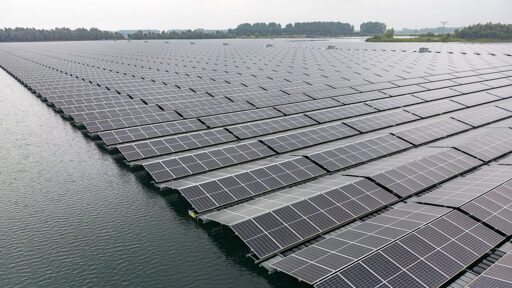The newest, hottest power couple doesn’t live in Hollywood. It’s actually the marriage of solar panels and water reservoirs: Known as floating photovoltaics, or floatovoltaics, the devices bob on simple floats, generating power while providing shade that reduces evaporation.
One primary advantage of the technology is that you don’t have to clear trees to make way for solar farms. As an added bonus, the water cools the panels, increasing their efficiency. Research has shown that if societies deployed floatovoltaics in just a fraction of the lakes and reservoirs of the world, they could generate nearly a third of the amount of electricity that the United States uses in a year.
As floatovoltaic systems rapidly proliferate — the market is expected to grow an average of 23 percent each year between 2025 and 2030 — scientists are investigating how the technology might influence ecosystems. The shading, for instance, might stunt the growth of algae that some species eat — but at the same time, it might also prevent the growth of toxic algae. The floats might prevent waterbirds from landing — but also might provide habitat for them to hide from predators. By better understanding these dynamics, scientists say that if companies are willing, they can work with manufacturers to customize floatovoltaics to produce as much electricity as possible while also benefiting wildlife as much as possible.
“Renewable energy, low-carbon electricity, is a really good thing for us, but we shouldn’t be expanding it at the cost of biodiversity loss,” said Elliott Steele, a postdoctoral researcher at the University of California, Davis, and co-author of a recent paper about floatovoltaics and conservation in the journal Nature Water. “This is a great opportunity for us to increase our research and develop smart design ideas and better siting practices in order to have this happy marriage between a healthy, biodiverse ecosystem and renewable energy expansion.”



Meanwhile, cities have little solar panels to show for. Not in rooftops, not in parkinglots… No implementation or improvement of photovoltaic windows either.
No no, let’s reduce light in lakes and especially the oceans, which produce 72% of the oxygen in the atmosphere and do the most carbon capture in the world. I swear this is just who has the stupidest idea now.
Solar farms on land are stupid. Floating Solar farms on lakes and ocean zones are even more stupid. Asphalt dead zones such as cities, and natural deserts it’s where this technology belongs.